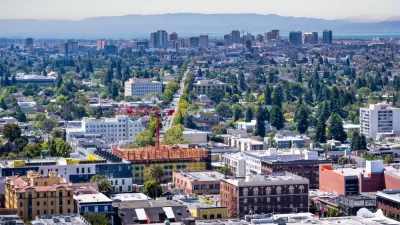A report providing recommendations for Berkeley's Housing Element update recommends allocating affordable housing and exploring a guaranteed basic income program for creative workers.

Berkeley's new Housing Element will include affordable housing and live-work spaces reserved for artists and "cultural workers," reports Berkeleyside's Supriya Yelimeli. A report based on a city survey also recommends consideration for a guaranteed basic income pilot program for people working in the arts.
These recommendations will be among several different priorities in the Housing Element discussion, which include affordable housing for marginalized groups, people who are homeless, families, residents who have been pushed out of Berkeley and the Bay Area, and many others, along with zoning changes to address the city’s legacy of racist housing laws.
The proposal's author, Councilmember Sophie Hahn, says the plan is one way to retain and bring back the creative class that fled Berkeley as housing prices rose. The report also highlighted the importance of safe live-work spaces, particularly in light of the Ghost Ship building fire that killed 36 in Oakland in 2016.
The article continues:
The Planning Commission referral suggests the city find space in commercial, manufacturing, and mixed-use buildings (in both new and existing properties), as well as exploring other possibilities. This would include affordable live-work spaces on the ground floor of some commercial areas, especially those on University Avenue and the San Pablo Avenue corridor in West Berkeley, which is considered the hub of the city’s arts, industrial and creative neighborhood.
The guaranteed basic income proposal would be modeled on similar programs in San Francisco and Minneapolis and, as the article notes, "would prioritize artists who are Black and people of color, and provide them with a monthly, unrestricted stipend to cover rent and food so they can continue their practice."
FULL STORY: Berkeley’s affordable housing talks will include plans to retain artists, ‘cultural workers’

Planetizen Federal Action Tracker
A weekly monitor of how Trump’s orders and actions are impacting planners and planning in America.

San Francisco's School District Spent $105M To Build Affordable Housing for Teachers — And That's Just the Beginning
SFUSD joins a growing list of school districts using their land holdings to address housing affordability challenges faced by their own employees.

The Tiny, Adorable $7,000 Car Turning Japan Onto EVs
The single seat Mibot charges from a regular plug as quickly as an iPad, and is about half the price of an average EV.

With Protected Lanes, 460% More People Commute by Bike
For those needing more ammo, more data proving what we already knew is here.

In More Metros Than You’d Think, Suburbs are Now More Expensive Than the City
If you're moving to the burbs to save on square footage, data shows you should think again.

The States Losing Rural Delivery Rooms at an Alarming Pace
In some states, as few as 9% of rural hospitals still deliver babies. As a result, rising pre-term births, no adequate pre-term care and "harrowing" close calls are a growing reality.
Urban Design for Planners 1: Software Tools
This six-course series explores essential urban design concepts using open source software and equips planners with the tools they need to participate fully in the urban design process.
Planning for Universal Design
Learn the tools for implementing Universal Design in planning regulations.
Smith Gee Studio
City of Charlotte
City of Camden Redevelopment Agency
City of Astoria
Transportation Research & Education Center (TREC) at Portland State University
US High Speed Rail Association
City of Camden Redevelopment Agency
Municipality of Princeton (NJ)





























